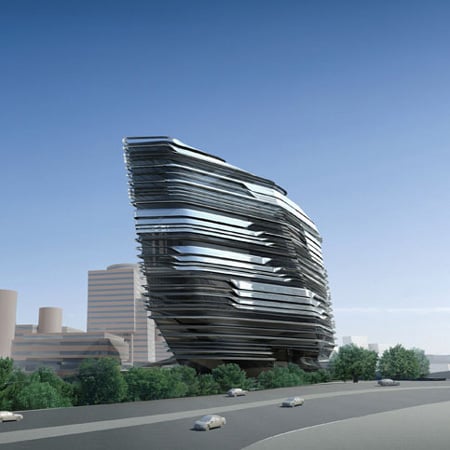
Innovation Tower at Hong Kong Polytechnic University by Zaha Hadid
Architect Zaha Hadid was appointed last month to design a new building on the campus of the Hong Kong Polytechnic University.
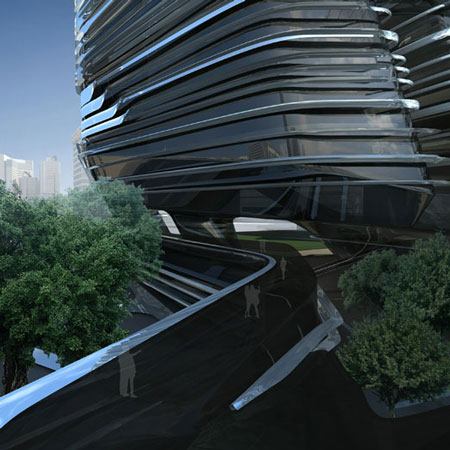
Called the Innovation Tower, the building will house the institute's School of Design.
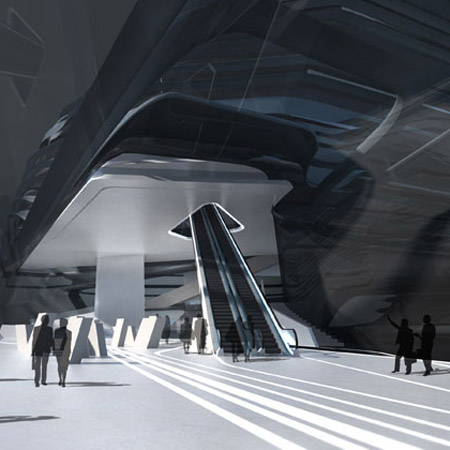
Below is text on the project from Zaha Hadid Architects, followed by a press release from the Hong Kong Polytechnic University:
--
INNOVATION TOWER, HONG KONG POLYTECHNIC UNIVERSITY [HONG KONG, CHINA] 2007-2011
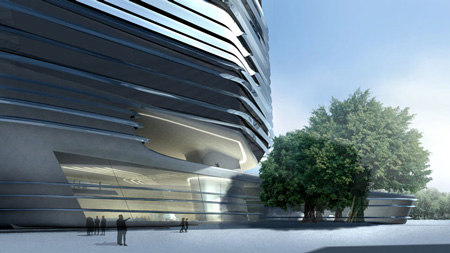
The fluid character of the Innovation Tower is generated through an intrinsic composition of its landscape, floor plates and louvers, that dissolves the classic typology of the tower and the podium into an iconic seamless piece. These fluid internal and external courtyards create new public spaces of an intimate scale which complement the large open exhibition forums and outdoor recreational facilities to promote a diversity of civic spaces.
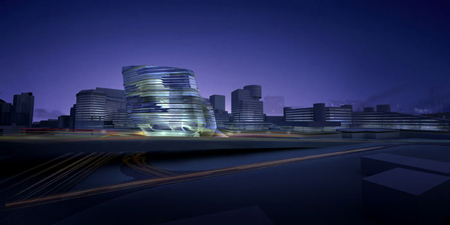
Urbanism
The Hong Kong Polytechnic University (HK PolyU) is an urban endeavour by virtue of addition and growth over the last 40 years. The rich patchwork of various faculties, communities and facilities are strung together by a community of visually coherent yet different buildings. From a process of outward expansion, the HK PolyU is now looking inwards to develop itself by making creative use of its remaining void on the North side of the campus.
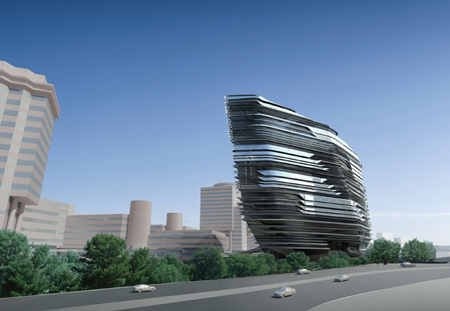
The Innovation Tower aims to use these voids to create an accessible urban space which will transform how the Hong Kong Poly University is perceived and the way it will be used. The building unashamedly aims to stimulate and project a vision of possibilities for its future, as well as reflect the history of the HK PolyU by encapsulating in its architecture the process of change.
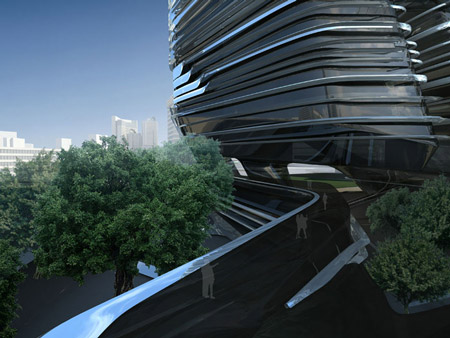
Architecture
The proposed vision of the new Innovation Tower presents a unique opportunity to re-examine and address a creative, multidisciplinary environment. Our concept in its first instance, collects the variety of programmes of the school. Having undergone a strict process of examination of the multiple relationships amongst their unique identities they have been arranged in accordance to their ‘collateral flexibilities’. Priority lies in the drawing in of the campus staff, students and public into a welcoming new space that acts as both the building’s entrance and organiser for the existing complex.

The first architectural gesture is to raise the landscape of the existing football field and tennis grounds, so as to place the main pedestrian entrance of the new school building on a level open to it’s immediate context at podium level. The free ground below becomes accessible from the established main campus route (Yuk Choi Road) to proposed workshops, parking and access to future development on ‘Phase 8’. The new Innovation Tower on podium level is established as an open public foyer that channels deep into the building through a column-free, open showcase forum. The long integrated path from Suen Chi Sun Memorial Square guides the visitor to the main entrance and from here, a generous and welcoming space openly leads its visitors access to supporting public facilities (shop, cafeteria, museum) through a generous open exhibition ‘showcase’ spanning over two levels between podium and ground level.
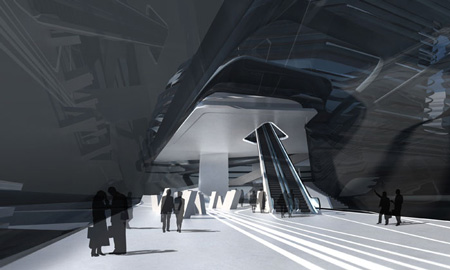
The podium level is a route that ramps and stretches through towards the open ground with relocated recreational outdoor facilities. From the entry foyer, a long escalator penetrates deep upwards through four levels of openly glazed workspaces. The myriad of workspaces accommodated within the new school offer themselves as a variety of visual showcases.
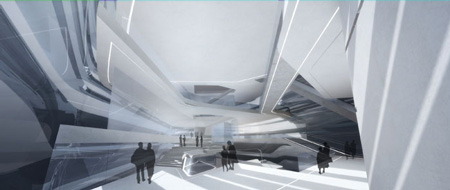
The route through the building becomes a clear upward cascade of showcases and events allowing the student or visitor to visually covet and engage work and exhibits throughout its circulation passage. These routes aims to promote new opportunities of interaction between the diverse types of users through its spaces through every level.
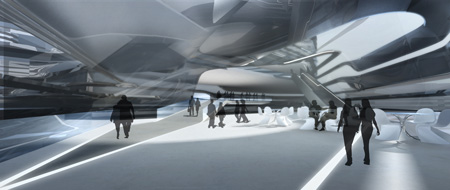
Voids bring in natural daylight, fresh air and the sense of continuity of space. In this way, the programmes of the tower, which comprise of learning clusters and central facilities, are allowed to create coordinated repertoires and dialogue between respective volumes.
PROGRAM: Innovation Tower, School of Design Development
CLIENT: Hong Kong Polytechnic University
ARCHITECT:
Design Zaha Hadid with Patrik Schumacher
Project Director Woody K.T.Yao
Project Leader Simon Yu
Competition team Hinki Kwong, Melodie Leung, Long Jiang, Zhenjiang Guo, Yang Jingwen, Miron Mutyaba, Pavlos Xanthopoulus, Margarita Yordanova Valova
CONSULTANTS:
Local Architect: AGC Design Ltd AD+RG
Structural & Geotechnical: Ove Arup & Partners Hong Kong Ltd
Building Services: Ove Arup & Partners Hong Kong Ltd
Landscape: Team 73 Hong Kong Ltd
Acoustic: Westwood Hong & Associates Ltd
--
Press release from Hong Kong Polytechnic University:
--
PolyU appoints Ms Zaha Hadid as Chief Architect of “Innovation Tower”
The Hong Kong Polytechnic University (PolyU) has appointed world-renowned architect Ms Zaha Hadid as Chief Architect of its new “Innovation Tower”.
Ms Hadid has made a trip from London to Hong Kong to present her design concepts at a press conference hosted by Mr Victor Lo Chung-wing, Chairman of PolyU Council; and Mr Alexander Tzang, Deputy President of PolyU.
Addressing the press conference, Mr Victor Lo said PolyU’s new “Innovation Tower” will serve as a driving force in the development of Hong Kong as a design hub in Asia. The new Tower will also provide additional space to facilitate inter-disciplinary research and education in the field of design.
The new Tower will be located at the northeast side of the university campus. Construction work will begin in 2009 and the whole project is expected to be completed by 2011. Upon completion, the Tower will provide some 12,000 square metres of net floor area and able to accommodate more than 1,500 students. This Tower will be the first permanent architectural design in Hong Kong by Ms Hadid.
“I am delighted to be working in Hong Kong again. The city has such diversity in its landscapes and history; this is reflected in an urbanism of layering and porosity. Our own explorations and research into an architecture of seamless fluidity follows this paradigm so evident in Hong Kong. One of our seminal projects was designed for the city exactly 25 years ago, and the Innovation Tower design is a realization of this continued research.” states Zaha Hadid.
“The Innovation Tower design dissolves the classic typology of the tower and the podium into a seamless piece. The design unashamedly aims to stimulate a vision of possibilities for the future whilst reflecting the history of the institution.”
Zaha Hadid is one of the most influential figures in the world of modern architecture. She is also the first female recipient of the coveted Pritzker Architecture prize, which is known in architecture as the equivalent of the Nobel Prize. She established her professional practice in London and her architectural designs can be found in major cities around the world. These include the BMW Central Building in Leipzig, Germany; the National Museum of 21st Century Arts in Rome; and the Olympics Aquatics Centre to be built in London.
PolyU Deputy President Mr Alexander Tzang added that the University has gone through stringent procedures in selecting Ms Hadid as Chief Architect of the project. The University has appointed a 10-member selection panel to screen some 48 submissions from local and overseas architectures and short-listed five proposals, taking into consideration both technical feasibility of the project and cost.
The new Tower will house the School of Design (SD) and support the development of its specialisms, namely Environmental Design, Industrial and Product Design, Visual Communication, Advertising as well as Digital Design. It will provide a congenial environment to support SD staff and students in their pursuit of excellence.
In this new “Innovation Tower”, there will be an advanced Car Design Studio; Fashion Accessories Materials Labs; a Sound Studio for Multi-media and Entertainment Design; a Museum to showcase local and international design classics; and a public gallery to exhibit works of staff and students of SD as well as local talents.
In Hong Kong, PolyU is the sole provider of design tertiary education and the city’s most important hub of design education and development. In recent years, SD has scaled new heights under the directorship of Prof. Lorraine Justice, who was named as the world’s top 40 influential designers by the ID magazine in the US.
SD has also made its mark, for two consecutive years since 2006, as one of the top 60 design schools in the world, according to independent surveys of design schools and design programmes conducted by BusinessWeek.
Design talents groomed by PolyU have won worldwide recognition and achieved astounding successes with their creativity and innovations. Famous graduates of SD include Oscar-winner and Supervising Animator for Shrek Mr Raman Hui, founder of the jewellery brand Qeelin Mr Dennis Chan, and Partner of Kan & Lau Design Consultants Mr Freeman Lau, to name but a few.